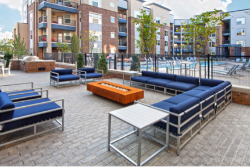In many big cities, the advent of the COVID-19 pandemic saw people fleeing urban areas for more space in the suburbs or beyond, leading to low occupancy rates in downtowns and other urban neighborhoods. Memphis, however, bucked that trend, with its multifamily market remaining strong throughout 2020 and improving into 2021.
Mark Fogelman, president of multifamily property investment and management company Fogelman, said his company, along with the wider Memphis market, did not see the same trends as Atlanta, Chicago or New York City. He said the overall Memphis market was about 96-97% occupied, generally considered full occupancy because there is always some vacancy from people moving in and out of properties.
Midtown development: Work to begin on retail portion of Orleans Station project
Suburban development: Germantown’s Thornwood site to build second hotel soon; residents address masking, vaccines
“While the traditional strong submarkets, Downtown, Germantown, Collierville, (led) the growth in the early part of this cycle, we are now seeing strength across every location and price-point in the market,” he said. “In my 27 years in the market, this is the strongest year I have seen for the local market, as well as the entire (Southeast) part of the U.S.”
Fogelman said that strength could be attributed to multiple sources, including changes in the single-family home market.
“Rental rates have definitely increased, but pricing for single-family homes has increased at a much greater level, pushing more demand into well-located, quality multifamily communities,” he said.
He said he also believed remote working trends established during the pandemic led people to move to areas that were more affordable. Cities like Nashville typically have attracted people looking to move to the South in pursuit of a lower cost of living than other parts of the country. Now, Fogelman believes people are looking elsewhere in the South, including Memphis, to avoid some of the hassles of the Music City, like traffic, and find even lower rents.
Average Memphis rent trending upward
According to RENTCafé, a website that tracks apartment listings and compiles data about the rental market nationwide, the average monthly rent in Memphis, for apartments of all sizes, as of June was $933, up from $773 three years ago.
The growth tracks with national trends. According to the National Apartment Association, national median rent has increased 11.4% since the start of the year, more than triple what was seen during that time period in pre-pandemic years.
Subscribe to read: Can a $30 million fund help minority developers launch projects in the Medical District?
‘A renaissance phase’: What does the new wave of development mean for Whitehaven?
Despite the local increase, RENTCafé’s Daniel Coste said moving into Memphis from the suburbs can help renters save money as well as find more space. People who have moved into the city in 2021 on average earn about $45,000 a year, while those who have moved out of the city this year are earning slightly more, on average $46,200.
However, new renters in the city come from multiple income brackets.
A RENTCafé analysis found renter activity — the number of people moving into, out of or within the city — in Memphis increased 8% in the first half of 2021. Much of that, according to data compiled by the website, was from high-earners. There was a 91% increase in apartment applications in Memphis from people earning more than $100,000 annually.
“Memphis is also the cheapest big city for renters seeking an upgrade to their apartment,” Coste said.
‘Buzz around Memphis’
Data from the Downtown Memphis Commission also speaks to the city’s strong multifamily market. According to the organization, occupancy for Class A apartment buildings — properties built in the past 15 years with top amenities — in Downtown has been at 95% or higher since 2018.
There are more than 10,000 total apartment units in Downtown Memphis, with more than 3,000 in the works, according to the DMC.
And there are many more apartments in the works in surrounding neighborhoods, which development officials have said are needed. According to a 2017 study from the Memphis Medical District Collaborative, more than 2,000 units could be developed and absorbed in the district between then and 2022.
More: Crosstown, Vollintine Evergreen now Memphis historic districts. What it means for residents.
Medical District: Single-family homes, duplexes planned near Le Bonheur
While major projects, like The Rise Apartments, have been completed, and more are underway, there are still more apartments that could be absorbed, and are needed for the continued growth of the Medical District, MMDC staff said.
Many more apartments have recently or are about to come online nearby in Midtown, with the Poplar Arts Lofts nearing completion and residents moving into part of the Madison Midtown development, among other projects.
Fogelman said that increased supply will be met with demand.
“Our Memphis portfolio has meaningfully outpaced national and regional results for each of the past three years,” he said. “While many of the traditional economic indicators … are not presenting a bullish picture for Memphis, we are seeing a different picture at the ground level. Local demand is up meaningfully; we are seeing (an) increase in ‘out of town’ and ‘out of state’ applicants; and there just appears to be increased vibrancy and buzz around Memphis right now.”
ARTICLE SOURCE
